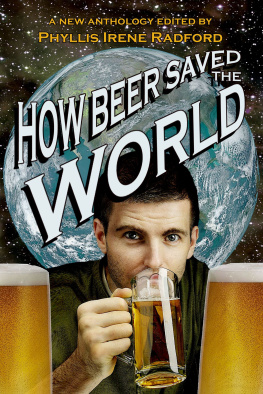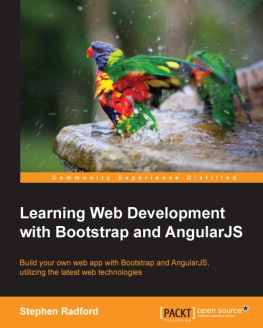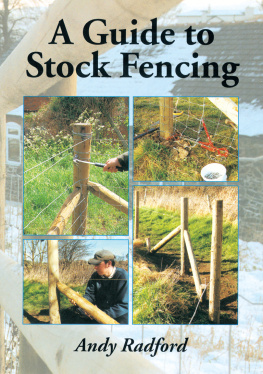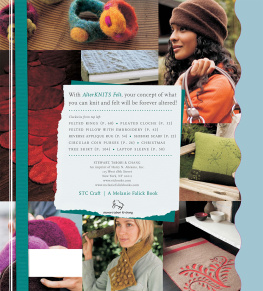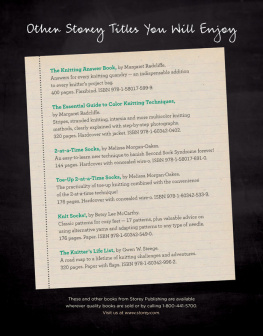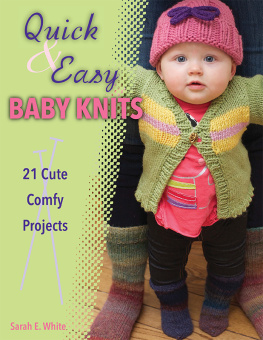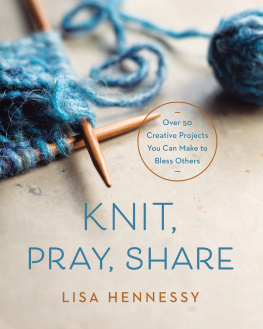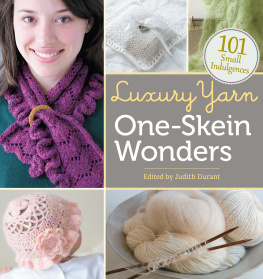


Published in 2009 by Stewart, Tabori & Chang
An imprint of Harry N. Abrams, Inc.
Text copyright 2009 by Leigh Radford
Photographs copyright 2009 by John Mulligan
All rights reserved. No portion of this book may be reproduced, stored in a
retrieval system, or transmitted in any form or by any means, mechanical,
electronic, photocopying, recording, or otherwise, without written permission
from the publisher.
Library of Congress Cataloging-in-Publication Data:
Radford, Leigh.
One more skein : 30 quick projects to knit / Leigh Radford ; photography
by John Mulligan.
p. cm.
ISBN 978-1-58479-802-6
1. KnittingPatterns. I. Title.
TT825.R284 2009
746.432046dc22
2008049040
Editor: Melanie Falick
Designer: Anna Christian
Production Manager: Jacqueline Poirier
The text of this book was composed in Neutraface.

www.hnabooks.com


Contents
Introduction
While I have always kept paint, drawing pencils, and a sketchbook close at hand, for most of the last decade Ive been more focused on knitwear design than painting and drawing. For a long period I didnt really see a connection between these two sides of my creativity. But around the time that I started working on this book, I also enrolled in art school. Early on in my classes I began exploring how I might incorporate knitting into my paintings, for example, by knitting my own canvas out of laceweight linen. And now when I review the collection of projects that Ive put together for this book, I clearly see that what I am learning in art class is seeping into and reenergizing my knitting.
In both areas, I am exploring ways to create aesthetically beautiful works as simply and cleanly as possible. These days when I come up with an idea, I ask myself if there is a way to pare it down in order to enrich it. The Pleated Vase Sleeve () makes lace look simple and bold rather than intricate and delicate, thanks to large needles and bulky yarn.
In my book One Skein, I included only projects that could be completed with one skein of yarn. For One More Skein, I gave myself slightly more leeway: All of the projects are made with one or two skeins of yarn except for the Albers Stash Blanket (), which is made with leftovers of many different colors (and is named for the acclaimed abstract painter and color theorist Josef Albers). I set out to develop classic projects that would be fun but not difficult to knit (and, depending on ones level of experience, might introduce a new technique), beautiful to look at, and useful for oneself or as a gift. Very few of them are worked at a small gauge, so they are quick to knit. There are quite a few projects for baby since, obviously, baby clothes require a minimal amount of yarn (often they can be made with leftovers from other larger projects), and because most knitters do tend to enjoy dressing up babies in handknits.
My favorite part of designing the projects for this book was the beginning, when I was sketching, swatching, and problem solving. Often I started with a simple concept instead of a particular type of project in mind. For example, I spent time sketching squares, manipulating them on a page, not at all sure where I was headed, before deciding that they would become the ) I decided to devote more space to the cable circles than to the rib pattern so that when worn, the design would be asymmetrical.
The key to all of this was taking time to explore the creative process. That was a gift to myself, the same gift that I hope you will give to yourself, perhaps inspired not only by the projects you see here but by my experience of delving into other areas of artistic expression outside of knitting in order to refresh my perspective on knitting.
Two needles and one (or one more) skein of yarnthe possibilities never cease to amaze me.


1 PUT IT ON

Fingerless Gloves
I love fingerless gloves and believe that you cant have too many pairs. I designed these after an early-morning bike ride during which my arms were a little chilly but the rest of my body was just fine (thus a jacket would have been overkill). They are worked flat, then sewn up the side, with a space left open for the thumb. You choose whether you want long gloves (see left) or short or striped ones (see ). You can also choose which side of the rib pattern you want to be the public side or, if you are careful with your side seams, you can make them reversible.
SIZES
Small (Medium, Large)
Shown in size Large
FINISHED MEASUREMENTS
5 (5 , 6 ) hand circumference
8 long, Short Gloves
12 long, Long Gloves
YARN
LONG GLOVES: Artyarns Ultramerino 8 (100% merino wool; 188 yards / 100 grams): 2 hanks #UM122. Note: If working with yarn from your stash, you will need approximately 310 (345, 376) yards.
LONG STRIPED GLOVES: Cascade 220 Heathers (100% Peruvian highland merino wool; 220 yards / 100 grams): 1 hank each #4005 (A) and #9327 (B). Note: If working with yarn from your stash, you will need approximately 68 (76, 85) yards A and 62 (70, 77) yards B.
SHORT GLOVES: Cascade 220 Heathers (100% Peruvian highland merino wool; 220 yards / 100 grams): 1 hank #9327. Note: If working with yarn from your stash, you will need approximately 78 (84, 95) yards. This pair was sewn together with the WS of the rib pattern facing out.
SHORT STRIPED GLOVES (not shown): Cascade 220 Heathers (100% Peruvian highland merino wool; 220 yards / 100 grams): 1 hank each A and B. Note: If working with yarn from your stash, you will need approximately 41 (44, 49) yards A and 37 (40, 45) yards B.
NEEDLES
One pair straight needles size US 8 (5 mm)
One pair straight needles size US 10 (6 mm)
Change needle size if necessary to obtain correct gauge.
GAUGE
20 sts and 22 rows = 4 (10 cm) in 31 Rib, using larger needles
24 sts and 26 rows = 4 (10 cm) in 31 Rib, using smaller needles
STITCH PATTERNS
31 Rib
Next page

